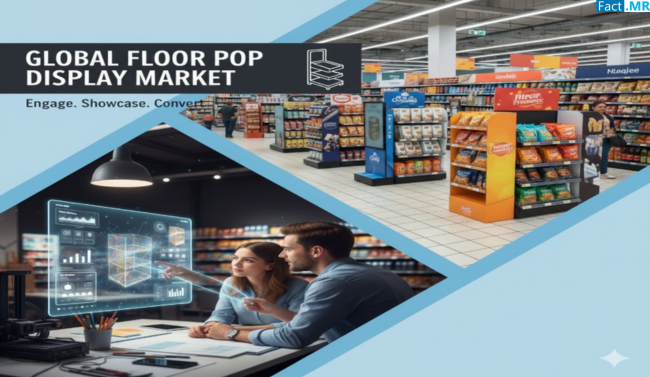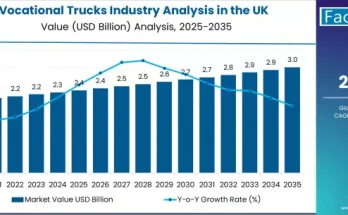Point-of-purchase (POP) displays are a crucial marketing tool in retail environments, designed to attract consumer attention, enhance brand visibility, and drive sales at the point of decision. Among these, floor POP displays have gained prominence due to their versatility, prominent placement in retail spaces, and ability to showcase products effectively. The floor POP display market has evolved significantly, driven by changing consumer behavior, technological innovations, and the increasing importance of in-store marketing strategies.
Market Overview
Floor POP displays are physical marketing structures placed on store floors, often near checkout counters or high-traffic areas. They are crafted from materials like corrugated boards, foam boards, plastic sheets, metal, and glass, offering durability, lightweight design, and aesthetic appeal. Retailers across sectors—such as food & beverages (F&B), cosmetics, pharmaceuticals, electronics, stationery, and automotive—leverage these displays to create engaging shopping experiences and promote promotional campaigns.
The market is shaped by the rising demand for customized, sustainable, and interactive display solutions. Brands increasingly prioritize unique designs, digital integration, and sustainability to align with evolving consumer expectations. The integration of digital technologies such as QR codes, interactive screens, and augmented reality is enhancing the engagement potential of floor POP displays.
Regional Insights
The global floor POP display market exhibits diverse regional dynamics:
- North America: Strong retail infrastructure and high adoption of marketing innovations drive demand. Retailers focus on interactive and eco-friendly displays to attract tech-savvy consumers.
- Europe: The market benefits from stringent sustainability regulations, pushing brands to adopt recyclable and reusable display solutions. Premium retail segments increasingly utilize floor POP displays to enhance customer experience.
- Asia-Pacific: Rapid urbanization, growing retail chains, and rising consumer spending are driving growth. Countries like China, India, and Japan are investing in technologically advanced displays to cater to dynamic consumer preferences.
- Rest of the World: Latin America and the Middle East are witnessing gradual adoption, with retailers recognizing the value of in-store marketing in enhancing brand recall and sales.
Key Trends & Market Drivers
- Sustainability and Eco-Friendly Materials
Sustainability is becoming a key factor in retail marketing strategies. Brands are transitioning from traditional materials to recyclable and biodegradable options such as corrugated cardboard and eco-friendly plastics. These materials not only reduce environmental impact but also resonate with environmentally conscious consumers.
- Digital and Interactive Displays
The integration of digital technology is redefining the functionality of floor POP displays. QR codes, touchscreens, and augmented reality features allow customers to engage with products digitally while maintaining the tactile appeal of physical displays. This convergence of physical and digital marketing is enhancing in-store engagement and boosting purchase decisions.
- Customization and Branding
Retailers increasingly seek custom-designed floor POP displays that reflect their brand identity. From color schemes and typography to structural design, customized displays help brands stand out in competitive retail environments. This trend is particularly strong in cosmetics, electronics, and F&B sectors.
- Compact and Flexible Designs
Floor POP displays are evolving to offer modular and flexible designs that can fit various retail spaces. Lightweight materials and easy assembly mechanisms make these displays adaptable for different product types, seasonal promotions, and pop-up campaigns.
- Experiential Marketing
Retailers are leveraging floor POP displays to create experiential environments that allow consumers to interact with products, try samples, or access promotional content. Experiential marketing enhances brand recall and encourages repeat purchases.
Applications & End-Use Outlook
Floor POP displays are widely adopted across multiple industries:
- Food & Beverages (F&B): Displays are used to promote packaged foods, snacks, beverages, and seasonal products. Eye-catching designs and strategic placement influence purchase decisions in supermarkets and convenience stores.
- Cosmetics: Cosmetics brands use floor POP displays to highlight new product launches, seasonal promotions, and best-selling items. Interactive features, such as testers and QR codes, engage consumers effectively.
- Pharmaceuticals: Floor POP displays are utilized in pharmacies to promote over-the-counter medications, wellness products, and seasonal healthcare items. Clear messaging and organized layouts support product visibility and trust.
- Electronics: Consumer electronics brands leverage displays for showcasing gadgets, accessories, and promotional bundles. Interactive displays allow consumers to experience products before purchase.
- Stationery: Stationery and office supply retailers use floor POP displays to organize products by category, highlight new launches, and support back-to-school campaigns.
- Automotive: Automotive and aftermarket sectors use displays to promote accessories, cleaning products, and vehicle care items, especially in retail chains and auto service centers.
Challenges & Market Restraints
Despite strong growth, the market faces challenges:
- Cost and Production Complexity: High-quality, customized, and digital-integrated displays can be expensive to design, manufacture, and deploy. Small retailers may face budget constraints.
- Durability and Maintenance: Frequent handling and in-store movement can damage displays, requiring maintenance or replacement. Ensuring longevity without compromising aesthetics is a challenge.
- Technological Integration: Incorporating digital elements requires technical expertise, software support, and ongoing maintenance, which may limit adoption among smaller brands.
- Changing Retail Landscapes: The growth of e-commerce impacts in-store marketing strategies, requiring floor POP displays to adapt to omnichannel experiences and experiential marketing needs.
Competitive Landscape
Leading players in the floor POP display market are focusing on innovation, sustainability, and technological integration. Companies are emphasizing:
- Eco-friendly material adoption
- Modular and customizable designs
- Digital and interactive display features
- Strategic partnerships with retailers for product launches
The competitive environment encourages continuous improvement in aesthetics, functionality, and customer engagement, ensuring that brands maintain visibility in increasingly crowded retail spaces.
Future Outlook
The floor POP display market is poised for continued growth, fueled by:
- Increasing investment in in-store marketing strategies
- Expansion of modern retail chains across emerging markets
- Rising consumer preference for engaging, interactive shopping experiences
- Integration of AI, AR, and digital tools to enhance display effectiveness
- Demand for sustainable and reusable display solutions
As brands seek to capture consumer attention and drive sales in a competitive retail landscape, floor POP displays will remain an essential tool for in-store marketing, combining creativity, functionality, and technology to create memorable shopping experiences.
Conclusion
The evolution of the floor POP display market reflects broader trends in retail innovation and consumer engagement. From sustainable materials to interactive technology and customizable designs, the market is adapting to meet the dynamic needs of modern retailers and consumers. By leveraging these trends, brands can enhance product visibility, boost sales, and create lasting connections with shoppers.
Floor POP displays are more than marketing tools—they are strategic assets that integrate creativity, technology, and retail insights, shaping the future of consumer engagement and in-store experiences.



